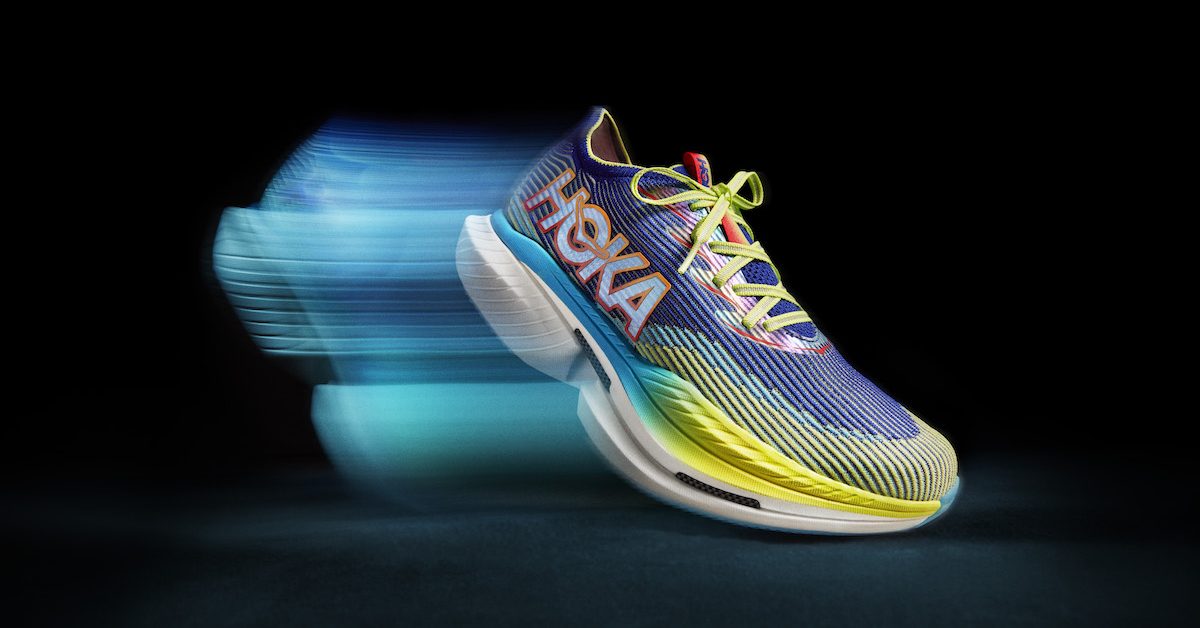Ahead of the Olympics, Hoka launches new shoes for both running professionals and amateurs

Hoka is banking on new running shoes to put its best foot forward ahead of the Summer Olympics and a new store opening.
On Thursday, the brand is releasing its new Cielo X1 road racing shoe, which is geared towards elite athletes taking part in timed events such as marathons, championships and Olympic trials. Hoka will also launch the Skyward X — a plusher, softer shoe — in April for those who are more casual walkers and runners. The shoes retail for $275 and $225, respectively.
Hoka debuted in 2009 as a performance running brand. Many of its original customers were professional athletes, marathoners and trail bikers. Thanks to the pandemic, though, Hoka’s cushioned shoes found a new audience: those looking for comfort. With its new shoes, Hoka is looking to appeal to both groups at once.
Each shoe sits at one end of a spectrum, with the Cielo X1 on the speed side, and the Skyward X on the everyday side. Together, the shoes are emblematic of Hoka’s product strategy going forward: creating new technology at either end of that range, and then applying it to items in the middle as a way to differentiate itself from competitors.
“We’re really aggressively taking learnings from these two new projects to help build out the rest of our line for the rest of the year and beyond,” Bekah Broe, Hoka’s head of performance footwear, told Modern Retail. “So, the things that make a fast shoe feel really fast and the things that make a soft shoe feel really soft will start to trickle across and fill out that spectrum in a fun, innovative way.”
Hoka plans to market the Cielo X1 as part of a new “FlyLab” campaign, which it will share on social media in the coming weeks. Meanwhile, it will highlight the Skyward X when debuting its new flagship store in New York City in May.
Hoka hopes both shoes will help power the business in the year forward. Hoka has repeatedly fueled record growth for its parent company Deckers; Hoka’s net sales increased 27.3% to $424 million for the three months ending Sept. 30, financial records show. Deckers reports its latest batch of earnings on Thursday afternoon.
Shaping the shoes
All of Hoka’s shoes share three basic components: the cushioning, the rocker of the shoe and the active foot frame, Broe said. The first refers to the compounds that Hoka puts in the shoe, such as carbon fiber plates. The second refers to the rounded shape of the sole, which helps the shoe move in a “rocking” motion. The third refers to how the shoe cradles the foot.
With all three, “we find ways to dial those up or down depending on the experience that we’re going for,” Broe said. The Cielo X1, for instance, has a rocker shaped like a banana so the shoe quickly touches the ground and pushes off. The Skyward X has a rocker that’s flatter for more sustained contact.
It took about two years to develop and test the Cielo X1 and Skyward X. With the Cielo X1, Hoka looked to make improvements to one of its existing shoes, the Rocket X2. In the past, athletes wearing that model had told Hoka they wanted something more extreme and aggressive, Broe said. “We’ve used feedback throughout the process on the Cielo X1 to inspire what comes next,” she said.
For about six months, professional runners wore and tested the shoe during events. Some, like Wesley Kiptoo, Kellyn Taylor, Alice Wright and Rachel Smith, ended up nabbing top spots at the finish line when wearing Cielo X1s. Hoka has five athletes competing this weekend in Orlando during U.S. marathon team trials for the Olympics, and some may wear the Cielo X1. Hoka will also host a pop-up at the races to highlight the Cielo X1 and other product innovations.
The running trend continues
Thanks to the pandemic, running shoe brands like Hoka are seeing sales soar to new heights, especially on marketplaces. In November, On reached its highest gross profit margin since its IPO two years ago, and New Balance and Asics hit new sales records for Black Friday at StockX. Brooks Running expanded into resale in July, encouraged by two years of record sales.
With so many brands jockeying for consumers’ attention, “the competition has definitely gotten stiffer in the running category,” Beth Goldstein, footwear industry analyst for Circana, told Modern Retail. “Brands are trying to be lighter, be faster, but also be wear-appropriate and more cushioned… Everybody’s just trying to one up what’s out there in the market right now.”
Innovation at this moment is key, Goldstein said, but so is flexibility. Hoka has made a name in performance shoes, but many of its sales come from people looking for casual-use products as well. With that in mind, Hoka’s strategy of developing shoes on both ends of the spectrum and then mixing and matching their technologies makes sense, Goldstein said.
What’s more, many apparel and footwear brands are incorporating performance elements into their products, Goldstein pointed out. Athleisure, for example, has gone beyond leggings and sweats to include breathable, functional fabrics. Jackets, shirts and socks sport moisture-wicking, anti-odor technology.
Likewise, Hoka wants to give shoppers performance and comfort, Broe said. “Innovation at Hoka never stops, and we’re never done answering questions for what we think can make the experience better for consumers,” she said.

